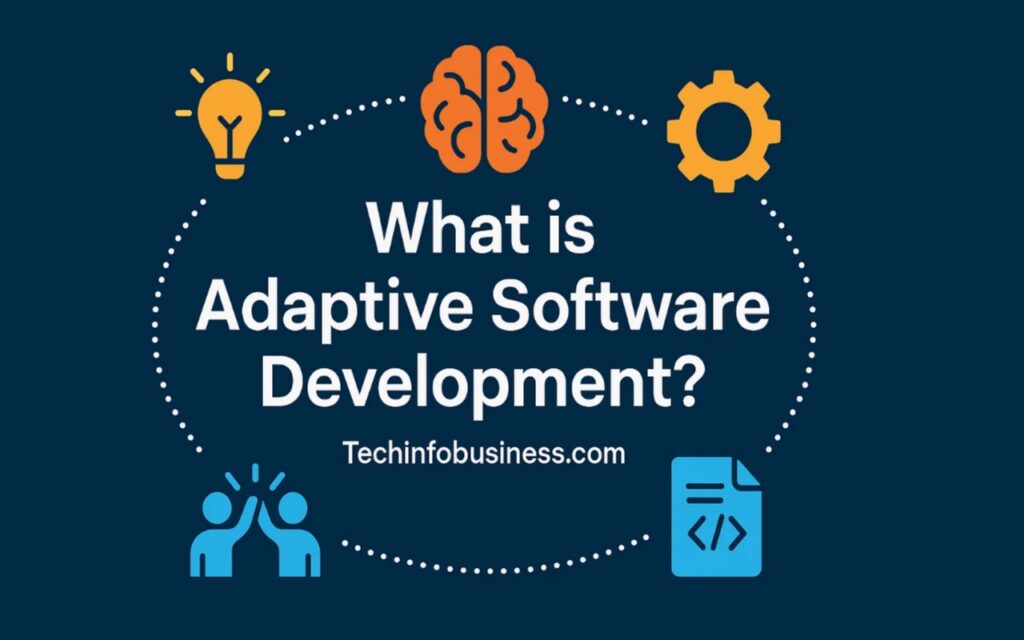In the world of software development, traditional methodologies have often struggled to keep up with the ever-evolving market demands and user needs. This is where Adaptive Software Development (ASD) steps in as a more flexible, iterative, and dynamic approach to software creation. Designed to adapt to changes throughout the development cycle, ASD enables teams to remain change tolerant and responsive to user feedback, ensuring that the product evolves with both the market and its users.
The key to adaptive software development lies in its continuous learning and iterative process. Instead of rigid planning, ASD allows for frequent product iterations, feedback loops, and real-time communication. It is an ideal approach for modern software systems where requirements often change and evolve as development progresses.
What is Adaptive Software Development?
Adaptive Software Development (ASD) is an iterative methodology that emphasizes flexibility, continuous feedback, and collaboration. It combines the core principles of Agile Software Development, such as team collaboration, user stories, and customer involvement, with a greater focus on responding to change. Unlike traditional models, where the software is built in sequential phases, ASD thrives on risk-driven planning and the constant evolution of both the product and the team’s understanding of the problem.
ASD is rooted in the belief that software development should be a flexible process that adapts to the changing needs of users and the market. Feedback cycles and learning cycles help teams adjust the product based on ongoing input, ensuring the end product is always aligned with user needs and market needs.
Key characteristics of adaptive software development include:
-
Flexibility: Adaptability to changes at any stage of development.
-
Responsiveness: The ability to react to user feedback and market shifts quickly.
-
Continuous Improvement: A constant refinement process through iteration and feedback.
Key Figures in Adaptive Development
The development of Adaptive Software Development owes much to the work of Jim Highsmith and Sam Bayer, who helped shape the Agile framework and Extreme Programming (XP). Jim Highsmith introduced principles that encouraged self-organizing teams, collaborative culture, and continuous improvement in software development. His work paved the way for risk-driven and lightweight planning methods within ASD.
Sam Bayer also made significant contributions, particularly around collaborative teams and maintaining a focus on customer involvement throughout the development process. His work emphasized that development should be driven by frequent feedback, and teams must be organized to respond to evolving user needs in real-time.
Their efforts influenced the creation of Agile Software Development, where the core values of collaborative culture, team collaboration, and user-first approaches became fundamental. Their methodologies also laid the groundwork for modern practices like Scrum and Lean Software Development.
Key Components of Adaptive Software Development
ASD consists of several critical components that allow it to function effectively in a fast-paced, changing environment:

-
Team Collaboration: One of the core aspects of ASD is team collaboration. Teams are organized into self-organizing teams that work closely with the Product Owner and stakeholders. This fosters strong communication and ensures the software stays aligned with real-world needs.
-
User Stories: User stories form the backbone of ASD, helping teams understand what the user needs and how to deliver it incrementally.
-
Customer Involvement: Customer feedback is continuously integrated throughout the development cycle. Frequent interactions with the customer ensure that development stays on track and meets the required expectations.
-
Continuous Testing: Tools like CI/CD pipelines are used to perform continuous testing, ensuring software quality and identifying issues early in the process. Regular testing helps reduce defect rates and software errors, allowing teams to resolve problems as they arise.
-
Version Control: Version control systems allow teams to track changes and maintain consistent documentation of the development process, ensuring that no work is lost and progress can be easily reviewed.
The Role of Continuous Learning in Adaptive Development
At the heart of Adaptive Software Development is the principle of continuous learning. This iterative process ensures that the software is always improving based on real-world feedback. The learning phase involves cycles where teams assess the outcomes of the previous iteration, incorporate user stories and customer feedback, and adjust their approach accordingly.
Through feedback cycles, teams can reduce defect rates and improve the software’s alignment with user needs. The development process is continually refined through learning cycles, where teams reflect on previous work and adjust for improvements.
For example, continuous testing allows teams to catch bugs early and make necessary fixes, leading to better software quality. The user-first approach ensures that development is always user-centered, allowing teams to adapt quickly to changes in user behavior.
Comparing Adaptive Development to Other Methodologies
Adaptive Software Development (ASD) is often compared to traditional approaches like Waterfall and modern Agile frameworks. Unlike Waterfall, which follows a rigid, sequential process, ASD is flexible and iterative, allowing for adjustments based on user feedback and changing market needs. While Agile emphasizes short cycles, ASD focuses more on continuous improvement and adapting in real-time, making it particularly well-suited for projects with evolving requirements. The table below highlights key differences between ASD and other methodologies.
| Aspect | Adaptive Software Development (ASD) | Agile Framework (e.g., Scrum, XP) | Waterfall | Spiral Model | Rational Unified Process (RUP) |
|---|---|---|---|---|---|
| Approach | Iterative and flexible, emphasizing constant adaptation to change. | Iterative, but generally follows defined cycles (sprints). | Linear and sequential, with clearly defined stages. | Iterative, but with a focus on risk assessment and mitigation. | Iterative, but with more detailed planning and documentation. |
| Planning | Lightweight planning with flexible adjustments based on feedback. | Lightweight planning, but more structured than ASD. | Heavy upfront planning with a detailed roadmap. | Risk-driven planning and frequent review of risks throughout. | Detailed upfront planning, with heavy documentation and processes. |
| Flexibility | Highly flexible and change-tolerant, able to adapt at any stage. | Flexible but constrained to certain time-boxed cycles. | Rigid and less flexible once planning is complete. | Flexible in terms of risk management but not highly adaptable. | Less flexible, but allows for adjustments during iterations. |
| Iteration & Feedback | Frequent feedback cycles with regular product iterations. | Frequent iterations and user stories with feedback loops. | No iteration; once a phase is completed, it cannot be revisited. | Iterative with a focus on refining risk analysis in each cycle. | Iterative but with more emphasis on structured phases and reviews. |
| Customer Involvement | Continuous customer involvement and feedback integration. | Strong customer involvement, especially through user stories. | Limited customer involvement until the product is delivered. | Customer involvement is minimal in the planning phase, but critical during each cycle. | Customer feedback is integrated, but the focus is on documentation. |
| Risk Management | Risk-driven planning, focusing on addressing risks early in the process. | Risk-driven, but managed through shorter cycles. | Risk is not actively managed in the process; addressed only when it arises. | Focused on assessing and mitigating risks early and continuously. | Risk is managed early but with heavy reliance on planning. |
| Documentation | Minimal documentation; only what’s needed to ensure functionality and progress. | Documentation is lighter than Waterfall but still necessary for sprints. | Extensive documentation throughout the process, which can slow progress. | Documentation is balanced with iterations, focusing on risk. | Detailed documentation and planning for each phase of development. |
| Time-to-Market | Faster time-to-market through frequent deliveries of working software. | Faster time-to-market due to frequent product increments. | Slow time-to-market as each phase must be completed before moving on. | Time-to-market varies based on risk cycles and assessment. | Time-to-market is slower due to detailed phases and documentation. |
| Strengths | – Adaptable to changing market needs and user behavior. | – Highly collaborative and encourages team collaboration. | – Predictable and well-structured. | – Helps mitigate risk early, ensuring fewer surprises later. | – Well-defined and structured with clear milestones. |
| Limitations | – Can be resource-intensive due to frequent iterations and feedback cycles. | – Can be challenging to scale for larger projects. | – Inflexible, making it hard to accommodate changes during development. | – Complex and can become cumbersome if risks are not adequately managed. | – Can be overly rigid and documentation-heavy, potentially slowing progress. |
Benefits of Adaptive Software Development
The adoption of Adaptive Software Development brings several key benefits, including:
- Enhanced Flexibility: ASD allows for better alignment with user needs through constant feedback and iteration, while user-first approaches ensure that products remain relevant throughout development.
- Faster Delivery: Frequent software increments and regular product iterations ensure that users see value earlier, enhancing satisfaction and trust.
- Improved Quality: The combination of continuous testing, real-time communication, and iterative development leads to higher software quality and fewer software errors.
- Better Collaboration: Through collaborative teams, stakeholder engagement, and the empowerment of self-organizing teams, ASD fosters a more cohesive and efficient working environment.
Challenges and Limitations
While the benefits of Adaptive Software Development are clear, there are challenges associated with its implementation:
- Requires Skilled Teams: ASD’s success is dependent on a skilled development team capable of making fast decisions and adapting to frequent changes. If the team lacks experience in Agile frameworks or Extreme Programming, they may struggle to manage the complexity.
- Scope Creep: Without clear project boundaries, adaptive development can lead to scope creep. Regular project management and lightweight planning are essential to maintain focus.
- Resource Intensive: Because of the frequent iteration cycles and feedback cycles, ASD can require more resources in terms of time and budget, particularly during the learning phase.
Despite these challenges, many teams find that the benefits of ASD outweigh the drawbacks, particularly in projects where requirements are uncertain or frequently changing.
Case Studies and Examples
Companies adopting Adaptive Software Development have successfully delivered products faster and with greater alignment to customer needs. For instance, organizations working with machine learning models and microservices 2.0 architectures have leveraged continuous improvement and real-time communication to enhance their products quickly.
By embracing customer feedback and user stories, these companies have been able to meet market needs and continuously adapt their products based on user input, ensuring that they stay ahead of competitors.
Read More: The Benefits of Custom Software Development for Unique Business Needs
Conclusion
Adaptive Software Development is a powerful methodology that has transformed the way software is built and maintained. By focusing on user involvement, customer feedback, and continuous learning, ASD enables development teams to create software that is responsive, flexible, and always aligned with both user needs and market demands. Its focus on team collaboration, continuous testing, and feedback cycles makes it an ideal choice for managing complex software projects in today’s rapidly changing technological landscape.
As we look to the future, the integration of technologies like event-driven architectures and machine learning will further enhance the adaptability of ASD, making it even more effective for managing next-generation software systems.


